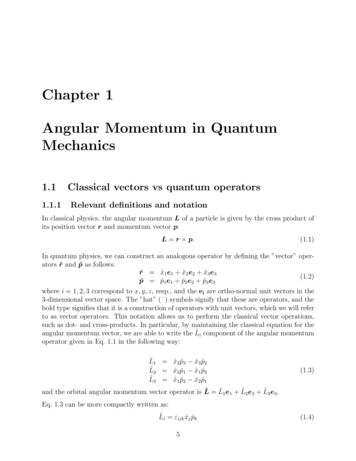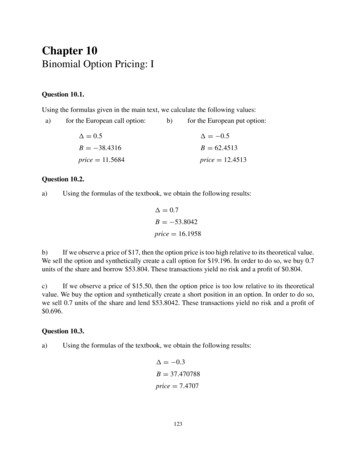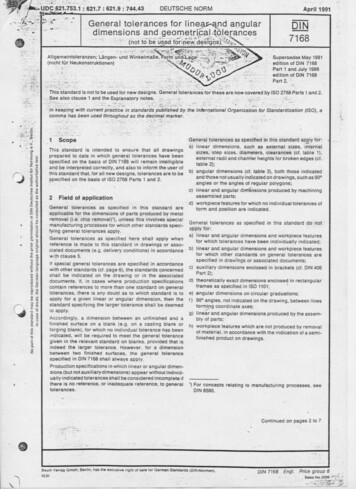
Transcription
BIOMECHANICAL MOVEMENTCHAPTER 6: Angular motion, projectile motionand fluid mechanicsfigure 6.1 – planes and axesAxis ASagittalFrontalAngular motionAngular motion is defined as the motion of a body which twists orturns about an axis as defined in figure 6.1. The twists, tumbles andturns involved in sports movements can all be described in this way.Axis BThree imaginary axes of rotationAxis CTransverseAn axis of rotation is defined as ‘an imaginary line about which thebody rotates or spins, at right angles to the plane’ – as in figure 6.1,axes labelled A, B and C. Longitudinal axis Axis A on figure 6.1. This axis runs vertically from the top of the head to a point betweenthe feet. Movements in the transverse plane about the longitudinal axis arerotational movements. Examples of sporting movements would be the spinning skater andthe hammer throw (figure 6.2).figure 6.2 – a hammer throwerturning around longitudinal axis Transverse axis Axis B on figure 6.1. This axis runs horizontally from side to side acrossthe body between opposite hips at right angles to the sagittal plane. Movements within the sagittal plane about the transverse axis areflexion, extension, hyperextension, dorsiflexion and plantarflexion. Sports movements about this axis include sit ups, and the high jumpFosbury Flop flight phase, and somersaults (figure 6.3). Frontal axis (also called the sagittal axis) Axis C on figure 6.1. This axis runs horizontally from front to back between belly buttonand lumbar spine. Movements in the frontal plane about the frontal axis includeabduction, adduction and spinal lateral flexion. Examples of sports movements about this axis are a cartwheel(figure 6.4), and the bowling action in cricket.figure 6.3 – a gymnast tumblingaround the transverse axisPlanes of the bodyThe term body plane is defined as ‘an imaginary flat surfacerunning through the centre of gravity of the body’, and isused to assist in the understanding of movement of bodysegments with respect to one another. Within each plane theturning axis can be identified as in figure 6.1.figure 6.4 – a cartwheel rotatingabout the frontal axisAngular motion 87
SECTION 4CHAPTER 6ANGULAR MOTION, PROJECTILE MOTION AND FLUIDMECHANICSAngleAngle is a familiar concept to most people, so it is readily understood what is meant by 30o,90o, 180o and 360o. In scientific terms, an angle is measured in radians. The radian as a unitof angle is defined as ‘the angle subtended at the centre of a circle by an arc lengthof one radius’. Suffice it to say at this point that one radian is approximately 60o.Angular displacementAngular displacement is defined similarly to displacement for linear systems and is therelative angle compared to some fixed position or line in space. For example, if a golferstarts his/her drive from the presentation position (i.e. with club just touching the ball) andbackswings to the fully extended position with the club behind his/her back, the club shaftwould have an angular displacement equal to the angle between the starting position andthe fully extended position of the backswing. This would be a measure of the fluency andrange of the swing and could be anywhere from 180o to 290o (or 3.142 to 5.06 radians).Angular velocityAngular velocity is the same thing as rate of spinning or twisting, and is defined as:angular velocity (w) angle turned (in radians)time taken to turnThis is a similar definition to that for linear velocity, except distance is replaced by anglein the formula.Angular accelerationAgain in a similar way to linear systems, it is possible to define angular acceleration as:angular acceleration change of angular velocitytime taken to changeThis concept applies to situations in which the rate of spin changes with time.Examples of this would be the hammer throw (in which the rate of spin increasesthroughout the movement up to the release of the hammer) and the tumbler, gymnast ordiver (who speeds up the rate of rotation or slows it down by changing his/her body shape).TorqueTorque is the twisting force which you could apply to a body to cause it to turn or spin.It is defined as the force applied to the body multiplied by the perpendicular distanceto the axis of rotation (the moment of force about the turning axis).This definition means that the bigger the force and the distance from the axis of turning,the bigger the turning effect.Moment of inertia (MI)This is the equivalent of mass (inertia) in the linear system, and is defined as:moment of inertia sum of [(mass of body part)x (distance of body part from the axis of rotation) squared]over all parts of the rotating body.Mathematically:MI S m r2Objects rotating with large MI require large moments of force (torque) to change theirangular velocity, and objects with small MI require small moments of force (torque) tochange their angular velocity or w.88
BIOMECHANICAL MOVEMENTMoment of inertiaThe formula on page 88 means that moment of inertia depends on the spread of massaway from the axis of spin, so as the body shape changes, the moment of inertia of theshape changes. The more spread out the mass, the bigger the MI.The unit of MI is kilogramme metre squared- kgm2. Bodies with arms held out wide havelarge MI, the further the mass is awayfrom the axis of rotation increases theMI dramatically.Sportspeople use this to control allspinning or turning movements.Pikes and tucks are good examples ofuse of MI, both reduce MI.figure 6.5 – moments of inertia of different shapeshigh barI 1 kgmI2I0.8I5I270IValues of moment of inertiaIn figure 6.5, I is the MI for the left most pin man and has a value of about 1.0 kgm2 for anaverage male person. From this diagram you can see how control of the arms will make a bigdifference to the value of MI, and that a tuck or pike can also change MI dramatically.Angular momentumAngular momentum is a quantity used to describe what happens when bodies spin and turn,it is defined as:angular momentum moment of inertia x angular velocity rotational inertia x rate of spinH IxwConservation of angular momentumThe law of conservation of angular momentum is a law of the universe which says thatangular momentum of a spinning body remains the same (provided no external forces act)figure 6.6 – moment of inertia is very largewith both arms and legs spread wideConservation of angular momentum 89
SECTION 4CHAPTER 6ANGULAR MOTION, PROJECTILE MOTION AND FLUIDMECHANICSConservation of angular momentum This means that a body which is spinning, twisting or tumbling willkeep its value of H once the movement has started. Therefore if moment of inertia (I) changes by changing body shape,then angular velocity (w) must also change to keep angularmomentum (H) the same. So, if MI (I) increases (body spread out more) then w mustdecrease (rate of spin gets less).And conversely, if MI (I) decreases (body tucked in more)then w must increase (rate of spin gets bigger). Strictly, this is only exactly true if the body has no contact with itssurroundings, as for example a high diver doing piked or tuckedsomersaults in the air, but it is almost true for the spinning skater!figure 6.7 – a spinning skaterfigure 6.8 – a tumbling gymnastSporting examples of conservation of angular momentum The spinning skater. If the arms are wide, the MI is large and theskater spins slowly. If the arms are brought in, MI is small and theskater will spin more quickly (figure 6.7). The tumbling gymnast (figure 6.8). With the body position open,the MI is large and the gymnast (or diver or trampolinist) will spinslowly. When he or she creates a tucked body position, the MI issmall and he or she will spin more quickly. The dancer doing a spin jump (figure 6.9). The movement is initiatedwith arms held wide which would therefore have the highest possible MI.Immediately he or she has taken off, the angular momentum is conserved,and so by tucking the arms across the chest, this will create the lowestpossible MI. This then means that he or she will acquire the highestpossible rate of spin, so that more spins can be completed before landing. figure 6.9 – a spinning dancerThe slalom skier. The slalom skier crouches on approach to the gateand therefore will have a large turning MI. As he or she passes the gate,he or she stands straight up (reducing MI). This enables the person toturn rapidly past the gate, then he or she crouches again (figure 6.10) increasing MI which will resume a slow turn between the gates.Newton’s laws of angular motionThe laws of angular motion are similar to Newton’s laws of linear motionexcept that they apply to turning, spinning, or twisting system or bodies.They are:90 Newton’s first law of angular motion states that a spinning orrotating body will continue with a constant angular momentumexcept when acted upon by an external force or torque. Newton’s second law of angular motion states that the rate ofchange of angular momentum of the body will be proportional to thetorque acting on it, and in the same direction (of spin) as the torque. Newton’s third law of angular motion states that when a torqueis applied to one body by another body, an equal but opposite indirection torque will be applied by the second body to the first body.figure 6.10 – a slalom skier
BIOMECHANICAL MOVEMENTProjectile motionFactors affecting horizontal displacement of projectilesThis section looks at the motion of objects in flight, such as human bodies (during the flightphase of a jump), throwing implements (shot, discus, javelin or hammer), and soccer, rugby,cricket, tennis and golf balls.The flight is governed by the forces acting, the weight, air resistance, Magnus effect (page 95),aerodynamic lift, and the direction of motion. If weight were the only force acting, the flightpath would be parabolic in shape, and some flight paths are similar to this (shot or hammer,the human body in jumps or tumbles or dives as in figures 6.11, 6.12, and 6.13, where weightis the predominant force acting).figure 6.11 – after take-off, a long jumper’sflight is governed by weight onlyfigure 6.12 – after release, the flight of a shotis governed by gravity onlyfigure 6.13 – after leaving the board, the flightof a diver is governed by gravity (weight) onlyProjectile motion 91
SECTION 4CHAPTER 6ANGULAR MOTION, PROJECTILE MOTION AND FLUIDMECHANICSFactors affecting horizontal displacement of projectilesFigure 6.14 summarises the factors which influence the distance travelled,the angle of release, the speed of release, and the height of release.figure 6.14 – factors affectingdistance travelledThe optimum distance moved before landing is acheived at 45o release angle.speed ofreleaseIf the height of release is about 2 metres off the ground, as in the shot put(figure 6.14), then the optimum angle of release (to achieve maximumdistance) will be less than 45o, probably approximately 42o.angle of releaseBut if the landing of the object thrown is higher than the point of release(as in the case of a basketball shot), then the optimum angle of releasewill be greater than 45o.height of releaserange of projectileThe relative size of forces during flightThe forces acting during flight are: the weight of the object, the air resistanceor drag, (the faster the projectile travels the greater will be the air resistance),aerodynamic lift, and the Bernoulli effect (page 94) or Magnus effect (page 95).If the shapes of the flight path differ from a parabola then some combination ofthese forces must be relatively large compared with the weight (rememberingthat a flight of an object with only weight force acting would be a parabola).figure 6.15 – forces on abadminton shuttlenctiodire otionof ma - fastFor example, the badminton shuttleaincestasir reFor a badminton shuttle struck hard (figure 6.15a), the air resistance is verylarge compared with the weight, because the shuttle is moving quickly. Theresultant force will therefore be very close to the air resistance. This wouldmake the shuttle slow down rapidly over the first part of the flight.weightresultant forceLater in the flight of the badminton shuttle (figure 6.15b), when the shuttle ismoving much more slowly, the air resistance is much less and comparable withthe weight. This pattern of the resultant force changing markedly during theflight predicts a pronounced asymmetric path.b - slowair resistanceFigure 6.16 shows a badminton shuttle’s flight path, which is markedlyasymmetric, because of the change of predominant force during the flight.direof ctionmotionresultant forceweightfigure 6.16 – asymmetric flight ofa badminton shuttle92
BIOMECHANICAL MOVEMENTVector components of velocity during flightFigure 6.17 outlines the vertical and horizontal componentsof the velocity during the flight of a projectile.At the middle of the flight: There is zero upward vertical component, since theobject moves entirely horizontally at this point. There is still a fixed horizontal component vh,which is the same as at the start.figure 6.17 – components of velocity during flightvvNear the end of the flight: There is a large downward vertical component vv,which is almost the same as the horizontal componentsince the object is travelling at approx 45o to thehorizontal downwards. vhheight reachedNear the start of the flight: There is a large upward vertical component vv. But a fixed horizontal component vh.vhvhdistance travelled by projectilevvThere is still a fixed horizontal component vh, which is the same as at the start.Fluid mechanicsfigure 6.18 – factors affecting fluidfriction or air resistanceFluid friction force depends on the shape and size of the moving object, the speedof the moving object, and the streamlining effect (summarised in figure 6.18).shapesizeFLUIDFRICTIONDrag and air resistanceIn order to minimise drag, the following developments affect sport: The body position and shape for a swimmer. The shape of helmets for cyclists. The use of lycra clothing. The shape of sports vehicles (cars or b
CHAPTER 6: Angular motion, projectile motion and fluid mechanics Angular motion Angular motion is defined as the motion of a body which twists or turns about an axis as defined in figure 6.1. The twists, tumbles and turns involved in sports movements can all be described in this way. Three imaginary axes of rotation An axis of rotation is defined as ‘an imaginary line about which the body .











